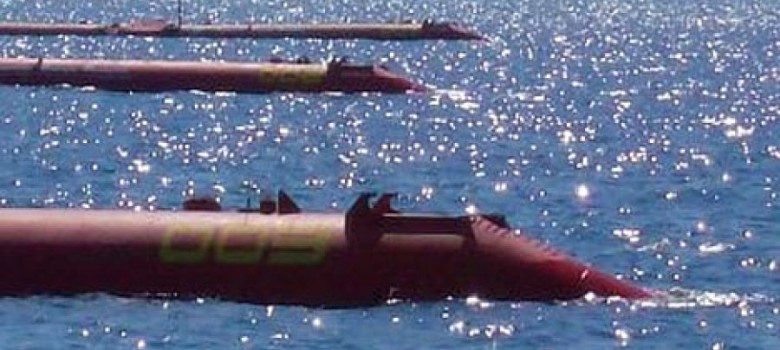
Agucadoura Wave Farm – Key Facts
In September 2008, following 10 years of design, refinement and testing, 3 Pelamis wave-following attenuation devices were installed 5km off the coast of Aguçadoura, Portugal, creating the world’s first wave energy farm.
Each 120m long Pelamis machine lays semi submerged on the surface of water that has a depth greater than 50m, and is composed of four long tube sections joined together by three power conversion units. The motion of each section flexing relative to one another results in high pressure oil passing through hydraulic motors driving electrical generators which are linked to the grid through cables along the seabed. At a cost of approximately $11.5million, the three Pelamis machines had an installed peak capacity of 2.25 MW, which is enough to power approximately 1,600 homes per year.
Efforts were taken to minimize the impact on local marine flora and fauna through, for example, a mooring system of embedment anchors, chains and ropes rather than more permanent gravity based systems.
Agucadoura Wave Farm Technical Issues
However in November 2008, technical issues resulted in the machines being brought to shore, and although these technical issues were resolved, the financial crisis sunk the Portuguese electricity utility Enersis’ parent company Babcock & Brown, resulting in the project ending much earlier than planned, and before any more of the anticipated 28 Pelamis machines had been built.
Following this disappointment, Pelamis shifted their focus onto a second-generation power generator, the P2. The P2 is longer and heavier allowing greater energy capture at lower cost per MW. The P2 also has a number of design improvements, increasing the efficiency and reliability.
Wave Farm Projects in the UK
There are currently two P2s being tested at the European Marine Energy Centre (EMEC) in the Orkneys, one being owned by E.ON, and the other by ScottishPower Renewables. ScottishPower Renewables have agreed a lease for a 50MW wave farm in Orkney with The Crown Estate that will be made up of 66 Pelamis machines, and the lessons and experience currently being accumulated at EMEC will play a vital role in the success of this plan.
Agucadoura Wave Farm – Next Steps
The Agucadoura Wave Farm, made up of a joint venture between Pelamis and now EDP and Efacec, hopes to receive a new lease of life in the form of a 20MW installed capacity follow-up project with 26 new Pelamis machines. As above, this project is dependent on the outcomes of the P2 testing in the Orkneys.
Portugal are especially hopeful that this follow-up project will be successful as wave power is going to be vital in their ambitious plans for 60% of the country’s energy to be from renewable sources by 2020. Portugal has an extensive coastline, most of which is exposed to the full force of the Atlantic and despite the initial failing of the Aguçadoura Wave Farm, Portuguese energy companies continue to invest in high-tech ocean solutions.












No Comments yet! Be the first one.